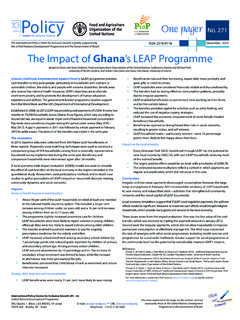Transcription of Tow ards Inclusive Governance - HRBA Portal
1 Towards InclusiveGovernanceUNDPR egional Centre in BangkokPromoting the Participation ofDisadvantaged Groups in Asia-PacificThe analysis, opinions and policy recommendations contained in this publication do not necessarilyreflect the views of 2007 UNDP United Nations Development ProgrammeRegional Centre in BangkokUN Service BuildingRajdamnern Nok AvenueBangkok 10200 and layout: Keen Media ( Thailand) Co., : 978-974-06-2837-8 Sales No.: E07 IIIB12 iiiForewordThis publication is the result of a collaborative effort among three regional programmes managed by the UNDP Regional Centres in Bangkok (RCB) and Colombo (RCC). The Centres are regional hubs for development knowledge and expertise, providing policy advisory, programming and capacity development services.
2 Inclusive Governance represents a priority area of work for UNDP in this region,examining the extent to which Governance institutions provide space to overcome the systematic exclusion of disadvantaged groups seeking to participate in decisions affecting of Inclusive Governance is widening the divide between rich and poor across Asia and the Pacific. Barriersto Governance structures Inclusive of disadvantaged and marginalized groups are preventing access by tensof millions in the region women, indigenous peoples, people with disabilities, victims of natural disastersand others to critical Governance services, as well as preventing them from exercising their human rightsand achieving higher levels of human inclusion of such groups is essential to overcome the deeply embedded social inequities and economic inequalities prevalent in the national circumstances differ across the Asia-Pacific region, governments face a common challenge.
3 To create an enabling Governance environment that is not only aware of, and responsive to, theneeds and interests of the most disadvantaged and marginalized but that also is willing and able to provide sound, effective remedies to these groups publication also examines the application of the principles of non-discrimination, participation,accountability and empowerment in Governance arenas, and promotes the use of a human rights-basedapproach to programming on Inclusive Governance . Presenting lessons learnt in eight Asia-Pacific countries through ten case studies, a strong case is made for greater inclusion in Governance as part of theagenda to deepen and consolidate democracy, ensure effective representation, and develop capacities tobetter respect, protect, and fulfil human trust that this selection of case studies can contribute to a better understanding of issues of inclusionand exclusion experienced by disadvantaged groups in the region, and provide an insight into the strategies appropriate for participatory interaction between these groups and Governance FongRegional ManagerUNDP Regional Centre in BangkokvAcknowledgementsThis publication owes much to many people.
4 The initiative was conceptualized and carried out by theUNDP Regional Centres in Asia-Pacific, through three regional programmes the Asia RegionalGovernance Programme, the Regional Initiative on Indigenous Peoples Rights and Development, and theAsia Pacific Gender Mainstreaming are due to UNDP Regional Centre in Bangkok staff for their sustained involvement in all stages ofthis project: Radhika Behuria, Marcia V. J. Kran, Helen Leake, Emilia Mugnai, Mary O Shea, Chandra Roy, RukkaSombolinggi, Arusha Stanislaus and R. Sudarshan. The project is also indebted to UNDP Country Office colleagues in Afghanistan, Bangladesh, Cambodia, India, Iran, Fiji, Philippines and Sri Lanka for their support, and in particular to: Aparna Basnyat, Emmanuel Buendia, Wouter Dol, Dilrukshi Fonseka, RadhikaHettiarachchi, Hanieh Khataee, Shashikant Nair, Jennifer Navarro, Kong Rady, Ahmad Salari, Pradeep Sharmaand core of this project is the case studies contributed by Shabnam Mallick, Raja Devasish Roy, Sara Hossain,Meghna Guhathakurta, Maria Backstrom, Jeremy Ironside, Sandra Bernklau, Amit Prakash, Sushma Iyengar,Shahla Moazami, Marvic Leonen, Ledivina V.
5 Cari o, Lionel Siriwardena and Amarasiri de Silva. Wethank them for their detailed analyses and commitment to the on the draft case studies were provided by the UNDP Regional Centre in Bangkok and ClarenceDias, consultant to the RCB. The key role played by Clarence Dias in drawing out common concerns, keystrategies for inclusion in Governance of excluded groups suggested by the case studies, is during the project was provided by Panvirush Vittayapraphakul, Kullawan Arphasrirat and SomlakSupkongyu, without which this publication would not be Kirby Dorji and Mark Bloch took up the indispensable role of editors and we thank them for theirunderstanding and cooperation in the final stages of this project.
6 Credit for the design/layout of this publication must go to Keen Media, Bangkok. viFunding programmesAsia Regional Governance Programme Asia Regional Governance Programme, a flagship programme covering the Asia region, focuses on operationalizing the link between democratic Governance and the MDGs by advocating for more responsive representative government, improving access to justice by the poor and disadvantaged groupsand promoting more effective partnerships for improved service Indigenous Peoples ProgrammeThe Regional Indigenous Peoples Programme aims to support regional dialogue and cooperation onindigenous peoples issues; developing regional public goods on critical issues and emerging trends;facilitating knowledge sharing and learning.
7 And strengthening the human and institutional capacity ofkey partners for more equitable and participatory s Policy of Engagement withIndigenous Peoples (2001) and the UN Declaration on the Rights of Indigenous Peoples (2007) provide theguiding Pacific Gender Mainstreaming ProgrammeThe Asia Pacific Gender Mainstreaming Programme is UNDP s regional programme aimed at engenderingeconomic policies and furthering women s economic rights and promoting gender-responsive Governance leading to greater gender equality and furthering women s empowerment. A rights perspective underpins the design and implementation of this programme. Its goal is the progressive realization of women s economic and political rights as guaranteed by major human rights treaties.
8 ContentsForewordiiiAcknowledgementsvFund ing programmesviIntroduction: Inclusive Governance for human development1 Clarence Dias and R. SudarshanParticipation of the disabled population in elections in Afghanistan14 Shabnam MallickAccess to justice for indigenous peoples: a case study of Bangladesh28 Raja Devasish Roy, Sara Hossain and Dr. Meghna GuhathakurtaIndigenous traditional legal systems and conflict resolution in Ratanakiri and Mondulkiri Provinces, Cambodia50 Maria Backstrom and Jeremy IronsideAn analysis of influencing family law: A case study of legislative advocacy and campaigning in Fiji66 Pacific Regional Rights Resource Team and Fiji Women s Rights MovementAdivasi rights in Jharkhand state, India82 Amit PrakashThe interface between formal and informal systems of justice:a study of Nari Adalats and caste Panchayats in Gujarat state, India99 Sushma Iyengar Access to justice: the case of women in Iran114 Shahla MoazamiThe irony of social legislation: reflections on formal and informal justice interfaces and indigenous peoples in the Philippines124 Prof.
9 Marvic LeonenParticipation and representation of disadvantaged groups in parliamentary processes in the Philippines144 Ledivina V. Cari oPromoting Inclusive Governance in tsunami recovery in Sri Lanka160 Aparna Basnyat, Dilrukshi Fonseka and Radhika Hettiarachchi 1 IntroductionInclusive Governance for human developmentClarence Dias and R. Sudarshan1 What is Inclusive Governance ?To be Inclusive is a core value of democratic Governance , in terms of equal participation, equal treatmentand equal rights before the law. This implies that all people including the poor, women, ethnic and religious minorities, indigenous peoples and other disadvantaged groups have the right to participatemeaningfully in Governance processes and influence decisions that affect them.
10 It also means that Governance institutions and policies are accessible, accountable and responsive to disadvantaged groups,protecting their interests and providing diverse populations with equal opportunities for public servicessuch as justice, health and Asia-Pacific region, with almost 60 percent of the world s population and a wide range of socio-economic and political issues, presents a challenging context for the promotion of Inclusive Governance . While the region has made rapid economic progress, these gains have not been distributedequally or equitably, either between or within countries. Underlying structures of inequality remain deeplyembedded in historical processes of discrimination and inequitable development.






